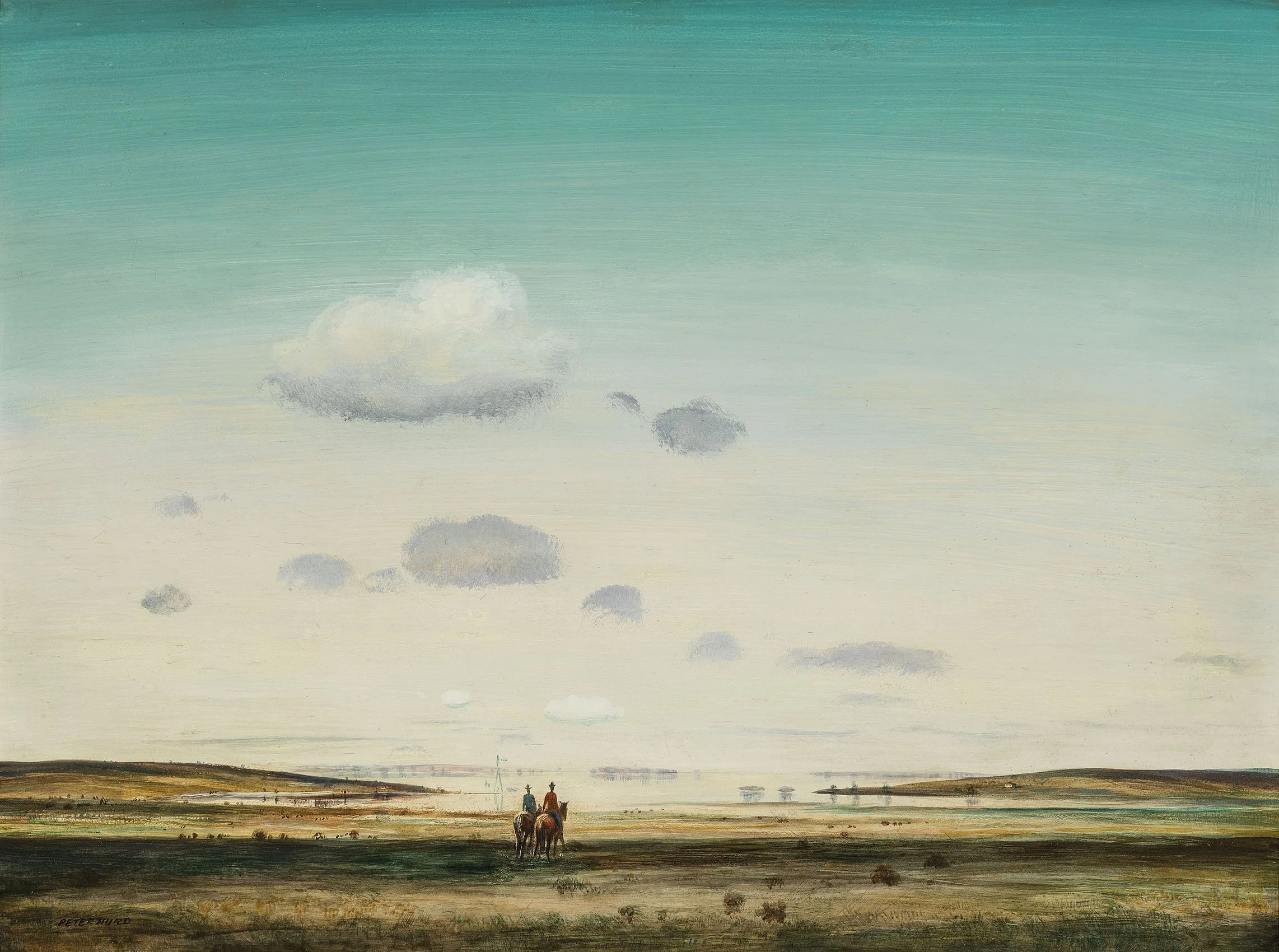PETER HURD (1904-1984)
Available Work | Biography
Biography • Peter Hurd (1904-1984)
Peter Hurd grew up in the small town of Roswell, New Mexico where he attended the New Mexico Military Institute and then spent two years at West Point from 1921 to 1922. Hurd was attracted to much of the Army cadet life as his father had served in the Spanish-American War. Throughout his military schooling, however, Hurd found time to sketch and ultimately he chose a life of art. After leaving West Point he briefly attended Haverford College then studied at the Pennsylvania Academy of the Fine Arts, from where he applied to become a private pupil to N. C. Wyeth.
Wyeth made it a policy not to take on pupils. But Wyeth, convinced by Hurd’s presence and grand spirit of purpose, surprisingly agreed to take the young artist under his wing. From 1924 to 1926 Hurd joined the Wyeth household in Chadds Ford, Pennsylvania, where everyone was talented and work was the honor of the family. There was a great sharing of talent and ideas within the Wyeth household, all of which Hurd soaked up, cultivating his artistic skill, personality, and self-realization. Hurd painted landscapes of the meadows of Chadds Ford with its small creeks, old stone barns, wooded hills, and views of the Brandywine Valley.
In his second year of apprenticeship, Hurd proposed to Wyeth’s oldest child, Henriette, who was also an artist. Hurd then returned to New Mexico where he was drawn to the vastness and immensity of the sky and the directness of the light. Away from Wyeth’s influence, Hurd developed a new style of expression, creating a technique of a gesso ground on which he painted thin washes of oil and then tempera. He returned to Chadds Ford to marry Henriette in 1929 and brought this new technique to share with Wyeth and his family.
In the early 1930s Peter Hurd and Henriette lived in a small farmhouse in Chadds Ford and worked all day in their studios in an old schoolhouse, given to them by Wyeth. In the mid-1930s Hurd brought Henriette to New Mexico, where they made their home in San Patricio, a small village fifty miles west of Roswell, in a section of land then called Sentinel Ranch. San Patricio was an irrigated valley with overgrazed hills of classic form and a thread of shallow river called the Ruidoso. While Hurd regularly spent many months each year in San Patricio, Henriette and his children did not move there permanently until 1939.
With Peter Hurd’s return to New Mexico, his paintings rapidly developed. Through his use of tempera and gesso, his depictions of the effects of light on the surrounding landscape had an incandescent quality. Hurd also worked in wash drawings, which he developed into gouaches and watercolors. In the mid-1930s Hurd undertook yet another medium, mural painting, when he joined the Federal Arts Project. Hurd won commissions to execute murals in the post offices of Big Spring, Texas; Alamogordo, New Mexico; and Dallas, Texas. Later he was commissioned to create murals for the grand public room of the New Mexico Military Institute. His regional landscape subjects and realistic execution were part of the American Scene style of art and came to represent many people’s vision of New Mexico. Hurd’s national recognition was acknowledged when Life magazine ran a pictorial and biographical essay about the artist titled “Peter Hurd Paints His Own Ranch in New Mexico” in 1939.
Peter Hurd had his first solo exhibition at MacBeth Galleries in New York in 1934 and another solo exhibition there in 1944. He had two solo exhibitions with Sullivan Gallery in New York in the late 1930s: 16 paintings were exhibited in Peter Hurd, Southwestern Painter in January 1937 and another exhibition Peter Hurd, Paintings, Drawings was held in April 1939. Hurd exhibited at many museum invitationals, including: the Corcoran Gallery of Art (1932-1957), the Whitney Museum of American Art (1937-1944), and the Pennsylvania Academy of the Fine Arts (1938-1944).
In 1942 Hurd became a Life artist war correspondent and was sent to England to paint the life of Britons at war. In the spring of 1943, awaiting his next assignment, Hurd was in Chadds Ford with his family. During his time there, he painted outdoor watercolors for the first time with Andrew Wyeth; previously he had worked up his drawings into watercolor in the studio. He used this experiment with watercolors in his next assignment for Life in India to record the instant, not the memory, of the war. This gave him great command of the watercolor medium and a new acuity of vision.
After the war and his return to New Mexico, Hurd spent more time painting large watercolors on the spot than ever before. He also continued to paint with tempera on gesso and executed sixteen murals in Lubbock for the Texas Technological College in the 1950s. Since the mid-1930s, Hurd’s other great love was polo. He put together his own team of scrappy ranch hands at San Patricio who went on to compete regionally and raised polo horses to fund the team. He wrote about his version of Southwestern polo in Sports Illustrated in 1954. Hurd had solo exhibitions at the Phoenix Art Museum in 1963 and the Oklahoma Museum of Art in 1968. A retrospective of Hurd’s work was organized by the Amon Carter Museum and traveled to the Palace of the Legion of Honor in San Francisco in 1965. Peter Hurd and Henriette Wyeth had joint exhibitions at the Oklahoma Museum of Art in 1965 and the Columbus Gallery of Art (now the Columbus Museum of Art), Ohio in 1967. Peter Hurd died in Roswell in 1984; the municipal museum there houses a rich collection of his work.




